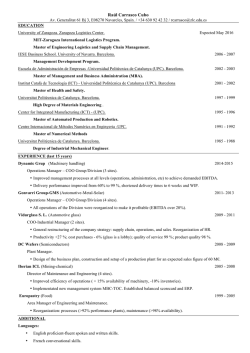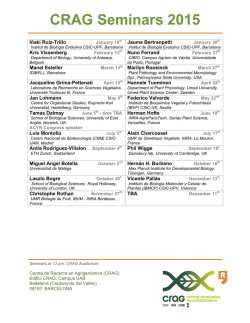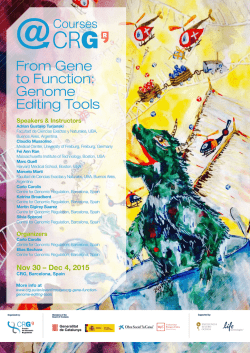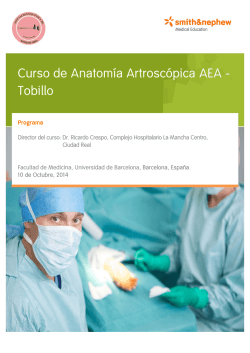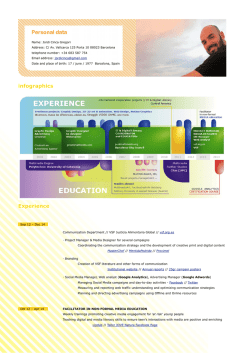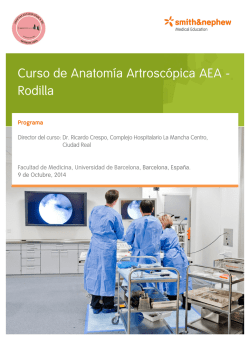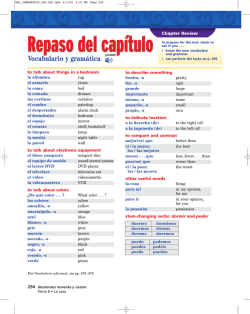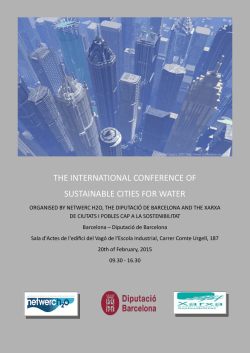
Sistemática. Taxonomía, Filogenia y Evolución
Comunicaciones Sistemática. Taxonomía, Filogenia y Evolución B1 Cestode fauna in wild mammals of the Canary Islands Carlos Feliu1,2, Pilar Foronda3, Ángela Fernández-Álvarez3, Jordi Miquel1,2, Jordi Torres1,2, Santiago Sánchez1 1 Laboratorio de Parasitología, Facultad de Farmacia, Barcelona, España IRBIO Institut de Recerca de la Biodiversitat, Barcelona, España 3 Instituto Universitario de Enfermedades Tropicales y Salud Pública de Canarias, Universidad de La Laguna, Tenerife, España 2 Ten years of research on the helminth fauna of free-living mammals in the Canary archipelago have enabled us to thoroughly describe the diversity of Cestodes in all hosts of the islands. There are data from 11 host species included, in the orders Insectivora, Rodentia, Carnivora, Lagomorpha and Artiodactyla. A total of 14 species of Cestodes were identified, of which 1 species belonged to the Mesocestoididae family, 3 to the Anoplocephalidae, 1 to the Catenotaeniidae, 2 to the Dipylidiidae, 4 to the Hymenolepididae and 3 to the Taeniidae family. The house mouse (Mus musculus) showed the highest biodiversity of Cestodes with 7 species, followed by the black rat (Rattus rattus) with 5 species, and the brown rat (R. norvegicus), the common rabbit (Oryctolagus cuniculus) and the cat (Felis catus) with 3 species each. The only hosts with absence of Cestodes were the Barbary ground squirrel (Atlantoxerus getulus) and the Barbary sheep (Ammotragus lervia). The highest prevalence of infestation was detected in O. cuniculus by Neoctenotaenia ctenoides (50.0%), followed by parasitization in the North African hedgehog (Atelerix algirus) by Mathevotaenia erinacei (42.8%), and both Rodentolepis fraterna and the larval stage of Taenia taeniaeformis in R. norvegicus (21.4%). In some hosts the prevalence of infestation by certain Cestode species was 100% (as in the case of Joyeuxiella pasqualei in F. catus) although these data cannot be considered significant owing to the scarce number of hosts studied (n=5). Despite the fact that in isolated ecosystems the loss of parasite species is common, we describe that this impoverishment has not been perceptible in the Canary archipelago, at least in the hosts mainly present in the islands. B2 Estudio molecular de Stenoponia tripectinata tripectinata (Siphonaptera: Ctenophtalmidae: Stenoponiinae) procedente de diferentes islas de las Islas Canarias: Taxonomía y filogenia Antonio Zurita1, Rocío Callejón1, Manuel de Rojas1, María Soledad Gómez2, Cristina Cutillas1 1 Departamento de Microbiología y Parasitología, Facultad de Farmacia, Universidad de Sevilla. Profesor García González 2. 41012 Sevilla. España. 2 Departamento de Microbiología y Parasitología, Facultad de Farmacia, Universidad de Barcelona. Avda. Joan XXIII. 08028. Barcelona, España. Las pulgas son insectos que han sido estudiados ampliamente a nivel de especie y subespecie pero, hasta la fecha, existen especies que no están asignadas a una familia en particular. Así, la familia Ctenophtalmidae es considerada como un “cajón de sastre” donde se agrupan especies muy diversas. Dentro de esta familia se encuentra la subfamilia Stenoponiinae que incluye especies de gran tamaño, y fuertemente pigmentadas. En el presente trabajo hemos llevado a cabo un estudio molecular de Stenoponia tripectinata tripectinata aislada de Mus musculus de diferentes islas de las Islas Canarias. Se han secuenciado y determinado el fragmento completo de los Espaciadores Internos Transcritos 1 y 2 (ITS1 e ITS2), el gen mitocondrial parcial citocromo c-oxidasa subunidad 1 (cox1) y el gen parcial 18S ribosómico, con el objetivo de clarificar la taxonomía de esta especie y evaluar las variaciones intraespecíficas e inter-específicas. Además, hemos llevado a cabo un estudio filogenético comparativo con otras especies de pulgas utilizando distintos métodos de reconstrucción filogenética. Se detectó una clara señal geográfica en el análisis de las secuencias del gen mitocondrial parcial cox1 entre los individuos de Stenoponia tripectinata tripectinata aislados de Mus musculus de las diferentes islas del archipiélago canario y aquéllos aislados del hospedador Apodemus sylvativus procedentes de la Península Ibérica. Nuestros resultados confirman el origen monofilético de la subfamilia Stenoponiinae, sugiriendo una línea genética distinta en relación a la familia Ctenophtalmidae. Por lo tanto proponemos la elevación de la subfamilia Stenoponiinae al nivel de familia (Stenoponiidae). Además en este estudio se llevó a cabo una detección molecular de las bacterias Bartonella sp. y Wolbachia sp. en todos los individuos muestreados. B3 Fertilization Taeniidae)* in the cestode Echinococcus multilocularis (Cyclophyllidea, Zdzisław Świderski1, Jordi Miquel2,3, Samira Azzouz-Maache4, Anne-Françoise Pétavy4 1 W. Stefanski Institute of Parasitology, Polish Academy of Sciences, Warsaw, Poland; 2Departament de Microbiologia i Parasitologia Sanitàries, Facultat de Farmàcia, Universitat de Barcelona, Barcelona, Spain; 3IRBio, Facultat de Biologia, Universitat de Barcelona, Barcelona, Spain; 4Laboratoire de Parasitologie et Mycologie Médicale, Faculté de Pharmacie, Université Claude Bernard-Lyon 1, Lyon, France Fertilization in the taeniid cestode Echinococcus multilocularis with uniflagellate spermatozoa, was examined by means of transmission electron microscopy (TEM). Fertilization in this species occurs in the oviduct lumen or in the fertilization canal proximal to the ootype, where the formation of the embryonic capsule precludes sperm contact with the oocytes. Cortical granules are not present in the cytoplasm of the oocytes of this species, however several large bodies containing granular material where frequently observed. Spermatozoa coil spirally around the oocytes and syngamy occurs by lateral fusion of oocyte and sperm plasma membranes. The crested bodies and cortical microtubules of spermatozoa apparently play a role in sperm entry, but their exact function has not yet been determined. In E. multilocularis, the process of fertilization can be summarized as follows: (1) the entire spermatozoon penetrates the oocyte; (2) its anterior anuclear part coils around the oocyte and penetrates first the oocyte cytoplasm; (3) the posterior nuclear part of the spermatozoon is the last to enter the oocyte; (4) the penetration is achieved by a complete lateral fusion of sperm and oocyte plasma membranes. In the ootype, one vitellocyte associates with fertilized oocyte, forming a membraneous capsule which encloses both cell types. In this stage, spirally coiled sperm flagellum initially adhering to the external oocyte surface, already enters much deeper into its perinuclear cytoplasm. The electron-dense sperm nucleus becomes progressively electron-lucent within the oocyte cytoplasm, after penetration. Simultaneously with chromatin decondensation, the elongated sperm pronucleus changes shape, forming spherical male pronucleus, which attains the size of the female pronucleus. Cleavage begins immediately after pronuclear fusion. *Study financially supported by the European Commission Contract KBBE 2010 1.3-01 265862 (PARAVAC). JM is a member of the AGAUR group (2014 SGR 1241). B4 Mastophorus muris (Nematoda: Spirocercidae) in mammals. Species or a species complex? Pilar Foronda1, Aarón Martín-Alonso1, Natalia Martín Carrillo1, Alexis Ribas2, Carlos Feliu2. 1 Instituto Universitario de Enfermedades Tropicales y Salud Pública de Canarias, Universidad de La Laguna, Canarias, España;2 Laboratorio de Parasitologia, Facultad de Farmacia, Universidad de Barcelona; I. Recerca de la Biodiversitat. Universidad de. Barcelona, España Mastophorus muris, a stomach nematode commonly found in rodents (Cricetidae and Sciuridae) and carnivores (Felidae, Canidae, Mustelidae y Viverridae) in island and continental ecosystems, has been historically identified by morphological methods. Several studies carried on the Canary Islands have allowed the detection of this nematode in Rattus spp. and Mus domesticus in all the seven islands and in one islet since 2006. The molecular analysis, based on internal transcribed spacers (ITS-1 and ITS-2), permitted the identification the identification of two different sequences. Whereas the first was related to the genus Rattus (M1), the second was only found in Mus specimens (M2). The further molecular studies of M. muris in continental hosts, Apodemus sylvaticus from the eastern Pirineo, Rattus norvegicus from Seville, and Rattus sp. from Thailand, demonstrated the specificity of genotype M1 for Rattus spp. and genotype M2 for genus Mus and Apodemus. Nevertheless, one black rat captured in el Hierro was found to be infected with genotype M2, and one house mouse was parasitized by genotype M1. Although morphologic differences have never been identified, this study warrants further analyses of mammals-related Mastophorus parasites, in order to analyze whether these molecular differences contribute to anatomical, morphometric and statistic differences. Acknowledgements: Research partly funded by the Government of the Canary Islands (A. M. A., grant number TESIS20100083), the Investigation Commission of the Faculty of Pharmacy (University of Barcelona), and the “Generalitat de Catalunya” (Project 2014SGR 1241). B5 Taxonomía y filogeografía de Trichuris globulosa Von Linstow, 1901, aislada de camellos. Una revisión de las especies de Trichuris parásitas de herbívoros Callejón R. 1, Zurita A. 1, Gutiérrez, L. 1, Halajian, A. 2, de Rojas, M. 1, y Cutillas, C. 1* 1 Departamento de Microbiología y Parasitología, Facultad de Farmacia, Universidad de Sevilla. España. Profesor García González 2, 41012 Sevilla, España. 2 Department of Biodiversity (Zoology), University of Limpopo, Turfloop Campus,Private Bag X1106, Sovenga, Polokwane, 0727, South Africa. La identificación a nivel de especie en el género Trichuris Roederer, 1761 es muy compleja y desde comienzos del actual siglo se ha citado sinonimias, especies crípticas e incluso nuevas especies de este género. La mayoría de estos estudios se han basado en la combinación de datos morfo-biométricos con datos moleculares desde que Dujardin en el año 1845 revisara por primera vez el género. En el presente trabajo, se ha llevado a cabo un estudio morfo-biométrico y molecular de poblaciones de Trichuris aisladas de Camelus dromedarius de Irán y de Ovis aries de Sudáfrica. Asimismo, se ha realizado un estudio comparativo con otras especies de Trichuris aisladas de diferentes especies hospedadoras y procedentes de diversos orígenes geográficos. El estudio molecular se ha realizado en base al Espaciador Interno Transcrito 2 (ITS2) del ADN ribosómico (ADNr) así como los genes citocromo c oxidasa 1 (cox1) y citocromo b (cytb) del ADN mitocondrial (ADNmt). Tras el estudio morfo-biométrico, la población de camellos de Irán fue identificada como T. globulosa. Por otra parte, se identificaron dos poblaciones de Trichuris aisladas de ovejas de Sudáfrica: T. ovis y T. skrjabini. Los datos obtenidos con los marcadores ribosómicos no revelaron diferencias significativas en las secuencias ITS2 de T. ovis y T. globulosa. Sin embargo, los datos mitocondriales sugieren que T. globulosa constituye un linaje genético diferente a T. ovis. Así, las secuencias parciales de los genes mitocondriales cox1 y cytb corroboraron la existencia de un linaje genético diferente de T. ovis procedente de Sudáfrica que está estrechamente relacionado con las poblaciones de T. globulosa de Irán. Además, en el presente trabajo se aportan por primera vez las secuencias parciales de los genes mitocondriales cox1 y cytb de T. globulosa. B6 Ultrastructural characters of the spermatozoon of the cestode Echinococcus multilocularis (Cyclophyllidea, Taeniidae)* Jordi Miquel1,2, Zdzisław Świderski3, Samira Azzouz-Maache4, Anne-Françoise Pétavy4 1 Departament de Microbiologia i Parasitologia Sanitàries, Facultat de Farmàcia, Universitat de Barcelona, Barcelona, Spain; 2IRBio, Facultat de Biologia, Universitat de Barcelona, Barcelona, Spain; 3 W. Stefanski Institute of Parasitology, Polish Academy of Sciences, Warsaw, Poland; 4Laboratoire de Parasitologie et Mycologie Médicale, Faculté de Pharmacie, Université Claude Bernard-Lyon 1, Lyon, France The mature spermatozoon of the taeniid cestode Echinococcus multilocularis was studied by means of transmission electron microscopy (TEM). Adult specimens of E. multilocularis were isolated from the intestine of a naturally infected red fox (Vulpes vulpes) from La Roche sur Foron (France). Mature cestodes were fixed in cold 2.5 % glutaraldehyde in a 0.1 M sodium cacodylate buffer at pH 7.4, post-fixed in cold 1 % osmium tetroxide with 0.9 % potassium ferricyanide in the same buffer, dehydrated in an ethanol series and propylene oxide, embedded in Spurr’s resin and polymerised at 60 °C. The mature spermatozoon of E. multilocularis is a filiform cell, tapered at both extremities and lacking mitochondria. It exhibits the general pattern of type VII spermatozoon of eucestodes. This type of sperm cell is characterized by the presence of a single axoneme, crested bodies, spiralled nucleus and cortical microtubules, a periaxonemal sheath and intracytoplasmic walls. The anterior spermatozoon extremity of E. multilocularis is capped by an electron-dense apical cone and this anterior extremity also exhibits the most interesting character, the so-called crested bodies. These are helical cords that surround externally the spermatozoon of most of cestodes and, if present, always mark the anterior spermatozoon region. In the male gamete of E. multilocularis there are two coiled crested bodies and this is a clear difference between spermatozoa of E. multilocularis and Taenia spp. (with a single crested body). This fact should be investigated in other species to confirm whether or not this is a characteristic of the genus Echinococcus. The remaining ultrastructural characters found in the spermatozoon of E. multilocularis show a similar morphology and location that in the studied species of the genus Taenia. *Study financially supported by the European Commission Contract KBBE 2010 1.3-01 265862 (PARAVAC). JM is a member of the AGAUR group (2014 SGR 1241).
© Copyright 2026
